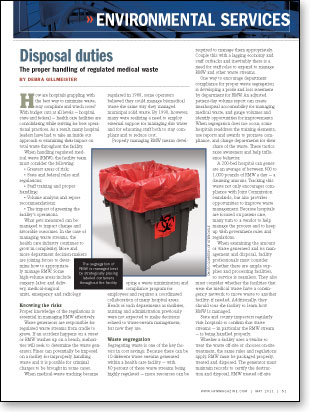 How are hospitals grappling with the best way to minimize waste, stay compliant and watch costs? With budget cuts at all levels — hospital, state and federal — health care facilities are consolidating while striving for best operational practices. As a result, many hospital leaders have had to take an inside out approach to examining their impact on total waste throughout the facility.
How are hospitals grappling with the best way to minimize waste, stay compliant and watch costs? With budget cuts at all levels — hospital, state and federal — health care facilities are consolidating while striving for best operational practices. As a result, many hospital leaders have had to take an inside out approach to examining their impact on total waste throughout the facility.
When handling regulated medical waste (RMW), the facility team must consider the following:
- Greatest areas of risk;
- State and federal rules and regulations;
- Staff training and proper handling;
- Volume analysis and report recommendations;
- The impact of greening the facility's operations.
What gets measured can be managed to impact change and favorable outcomes. In the case of managing waste streams, the health care industry continues to grow in complexity. More and more department decision-makers are joining forces to determine how to appropriately manage RMW. Some high-volume areas include surgery, labor and delivery, medical-surgical units, emergency and radiology.
Knowing the risks
Proper knowledge of the regulations is essential in managing RMW effectively.
Waste generators are responsible for regulated waste streams from cradle to grave. If an accident happens on a street or RMW washes up on a beach, authorities will seek to determine the waste generator. Fines can potentially be imposed on a facility for improperly handling waste and it is possible for criminal charges to be brought in some cases.
When medical-waste tracking became regulated in 1988, some operators believed they could manage biomedical waste the same way they managed municipal solid waste. By 1990, however, many were realizing a need to employ external support for managing this waste and for educating staff both to stay compliant and to reduce cost.
Properly managing RMW means developing a waste minimization and compliance program for employees and requires a coordinated collaboration of many hospital areas. Heads of such departments as facilities, nursing and administration previously were not expected to make decisions related to waste-stream management, but now they are.
Waste segregation
Segregating waste is one of the key factors in cost savings. Because there can be 10 different waste streams generated within a health care facility — with 80 percent of these waste streams being highly regulated — more resources can be required to manage them appropriately. Couple this with a lagging economy and staff cutbacks and inevitably there is a need for staff roles to expand to manage RMW and other waste streams.
One way to encourage department compliance for proper waste segregation is developing a profit and loss statement by department for RMW. An adjusted patient-day volume report can create intrahospital accountability for managing medical waste, and gauge volumes and identify opportunities for improvements. When segregation does not occur, some hospitals readdress the training elements, use reports and awards to promote compliance, and charge departments for their share of the waste. These tactics raise awareness and help influence behavior.
A 200-bed hospital can generate an average of between 800 to 1,000 pounds of RMW a day — a daunting amount. Tracking this waste not only encourages compliance with Joint Commission standards, but also provides opportunities to improve waste management. Because hospitals are focused on patient care, many turn to a vendor to help manage the process and to keep up with government rules and regulations.
When examining the amount of waste generated and its management and disposal, facility professionals must consider whether there are ample supplies and processing facilities, so service is seamless. They also must consider whether the facilities that treat the medical waste have a contingency network to move waste to another facility, if needed. Additionally, they should tour the facility to learn how RMW is managed.
State and county inspectors regularly visit hospitals to confirm that waste streams — in particular the RMW stream — is being handled properly.
Whether a facility uses a vendor to treat the waste off-site or chooses on-site treatment, the same rules and regulations apply. RMW must be packaged properly, treated and disposed. The generator must maintain records to certify the destruction and disposal. RMW treated off-site requires documentation from the vendor who treated the waste.
Waste treated on-site requires documentation and appropriate record-keeping of the effectiveness of the treatment process. During an inspection, hospital leaders may be asked by the county, city, Occupational Safety and Health Administration (OSHA), or the Joint Commission for these records, going back two to three years. A best practice is making this documentation available online, including all permits and manifests demonstrating the medical waste-handling process.
The ability to scan and track each collection will help avoid violations and can provide a detailed breakdown of the number of containers by department, floor and building, as hospitals may have many buildings on one campus. This also identifies areas where additional compliance education is needed.
Additionally, during surveys or state inspections, records are checked to determine whether hospitals are compliant with specific training requirements for those handling internal hospital transport of RMW or signing the Department of Transportation (DOT) manifests. The hospital staff handling RMW is required to have DOT training every three years. Hospital educators are not typically the subject matter experts. Consequently, hospitals may need to use others for these services.
Effective management
Staff must be trained and assessed to assure they understand the biohazard and infectious nature of regulated medical waste. RMW is generated during diagnosis, treatment or immunizations, and includes sharps, trace chemotherapy and pathological waste. A trained and compliance-focused workforce knows that minimization, segregation, treatment and disposal will maintain employee health and safety according to OSHA standards and is the right thing to do.
Health facility professionals should set goals for the amount of waste per waste stream. Staff can manage the segregation of RMW proactively by developing a system for the strategic placement of labeled containers. When RMW is properly segregated, the volume is minimized.
Health care facilities should track their waste by adjusted patient day. Or, for instance, a 1,000-bed hospital operating at 80 percent capacity likely will generate 1 million pounds a month.
Facility professionals should seek to benchmark their numbers against best practices through such organizations as Practice Greenhealth. For instance, facilities striving for best practices achieve approximately 9 percent of RMW from the total waste stream, according to the 2010 Environmental Excellence Awards Sustainability Benchmark Report from Practice Greenhealth (www.practicegreenhealth.org/awards/environmental-excellence-awards-benchmark-report). Setting goals can help lessen the facility's amount of non-RMW waste ending up in biohazardous containers and have an impact on the bottom line.
If medical waste is not managed internally, due diligence should be taken when choosing a company for treatment and disposal. Management of waste services is a fragmented industry. If choosing a small operator, health facility professionals must confirm that it is licensed to dispose of RMW and has a record of compliant disposal. Cases like a recent one in Cocoa, Fla., ended in the arrest of an operator for disposing of medical waste in a residential area.
Regardless of who is managing RMW disposal, the responsibility still lies with the generator and facility professionals. The risk does not stop because the waste left the facility's dock.
Health facility professionals also are required to develop and document a disaster and emergency-preparedness plan for handling RMW. This provides hospitals with defined processes and contingency plans should their primary waste facility become temporarily disabled. If there is a hurricane, does the service provider supply them with ample supplies ahead of time in case they are cut off from main access roads, or have a plan to assure they will have service?
Finally, the adage "reduce, reuse, recycle" defines the level of environmental impact. After reducing the amount of waste that is complex and costly to treat and dispose, the next best step is to reuse where possible. Reusable sharps containers decrease facilities' carbon footprints and decrease RMW and landfill waste.
There is less need for single-use containers because effective and compliant disinfection and handling is available for reusable containers. This practice serves both to reduce the amount of plastic and minimize the waste generated.
By moving away from single-use containers, a facility also can eliminate thousands of corrugated boxes, minimize the storage space needed to hold them, and reduce the staff time to assemble and exchange containers. One reusable container prevents 600 disposable containers from going to the landfill.
Since 1986, more than 100 million disposable containers have been kept out of landfills worldwide. As with RMW waste, the same methodology should be exercised when evaluating reusable sharps container providers.
An effective program
Properly handling RMW is a complex process, but the complexity can be managed if a health facility establishes an effective program.
Debra Gillmeister is director of Lake Forest, Ill.-based Stericycle's health care services division. She can be contacted via e-mail at DGillmeister@STERICYCLE.com.
| Sidebar - Advice on setting up an RMW management system |
| Starting or renewing a program for managing regulated medical waste (RMW) should include perspectives from many departments within a health care facility. This should translate into a team dedicated to evaluating the facility's needs and options to meet its RMW requirements. The team should include representatives from infection prevention, nursing, facilities management, environmental services and materials management. They can offer insight into the type of RMW generated and challenges each department faces. The infection preventionist team is concerned about infection-risk points within a facility and maintaining patient and staff health. Nursing teams treat patients and then take the biohazardous waste to specified RMW containers. This requires easy access without interfering with their clinical routines. Facilities management, environmental services and housekeeping staff remove containers from clinical areas and transport through patient areas to the back dock of the hospital. They understand the volume of waste moved to the dock. Other departments to include are safety, quality and risk management to gain a comprehensive overview and create buy-in for implementing a successful RMW protocol. A green team creates goals so the facility can begin to operate in an environmentally friendly manner. The team can develop training programs to help staff understand the impact of putting waste into appropriate receptacles to reduce the facility's carbon footprint. Materials management leadership can identify performance metrics to help analyze the program's success. If the facility is choosing a vendor for managing, treating and disposing RMW, facility professionals should have a list of questions to identify the challenges and opportunities for reducing infectious waste. They also should establish realistic goals and timelines, assess regulatory mandates, review policies and procedures, train and assess staff, review current waste volumes, and conduct monthly and quarterly program reviews. Smart facility professionals also ask the following:
A compliant, sustainable and cost-effective process for managing RMW allows a health facility to stand out from the pack. |
| Sidebar - The regulatory complexities of managing RMW |
| There are thousands of health care facilities in the United States. How many of them prepare for Joint Commission surveys with mock compliance audits is unknown. One goal that facilities always should strive for is to be compliant and to know the expectations before a surveyor visit, which is unannounced and can be every 18 to 36 months. A survey includes questions regarding the health care facility's compliance with laws and regulations. These include the leadership process, clinical management of medications, environment of care or emergency management preparedness and more. Finally, a human resources component sets the expectation for staff education and continual assessment of competencies. For U.S. hospitals, whose numbers have shrunk from those of several years ago, an average of 40 to 60 percent of revenues come from the Centers for Medicare & Medicaid Services. These hospitals and their staff members must be dedicated to regulatory compliance, performance improvement and quality assurance. Keeping the health care facility current with standards is tied to accreditation, the backbone from which a hospital operates and why facility professionals keep up to date through such websites as www.JointCommissionConnect.org and www.JointCommission.org. Most health facility professionals appreciate the need to understand the regulatory complexities of managing waste. There are many regulations and standards, including the Joint Commission's Leadership (LD), Environment of Care (EC) and Emergency Management (EM) standards, as well as the Department of Transportation, Environmental Protection Agency and various local, state and federal rules and regulations. Many, but not all, of the standards relating to regulated medical waste include the following:
A health care organization can be fined thousands of dollars per day per violation by local, state and federal authorities if it is deemed noncompliant with waste regulations. Many of these fines vary by state. Health care facility professionals should know their state's existing and emerging regulations to avoid costly fines and remain a compliant leader within the health care industry and their community. |





